Literature Review: Cyber Security Challenges for Businesses
VerifiedAdded on 2020/03/04
|9
|2807
|309
Report
AI Summary
This literature review delves into the critical challenges of cyber security within the contemporary business landscape. It underscores the increasing importance of cyber security as businesses increasingly rely on cloud services and digital data storage. The review analyzes key challenges, including malware threats, USB encryption issues, data loss prevention, the need for robust emergency response strategies, and the complexities of mobile device management. It emphasizes the evolving nature of cyber threats and the need for businesses to adopt proactive measures to safeguard sensitive data, intellectual property, and digital assets. The analysis highlights the necessity of a multi-faceted approach to cyber security, encompassing technical solutions, strategic planning, and employee training to mitigate risks and ensure business continuity. The review synthesizes existing literature to provide a comprehensive overview of current challenges and the imperative for continuous adaptation in the face of evolving cyber threats.

Literature Review
Challenges in Cyber Security for Business
Challenges in Cyber Security for Business
Paraphrase This Document
Need a fresh take? Get an instant paraphrase of this document with our AI Paraphraser
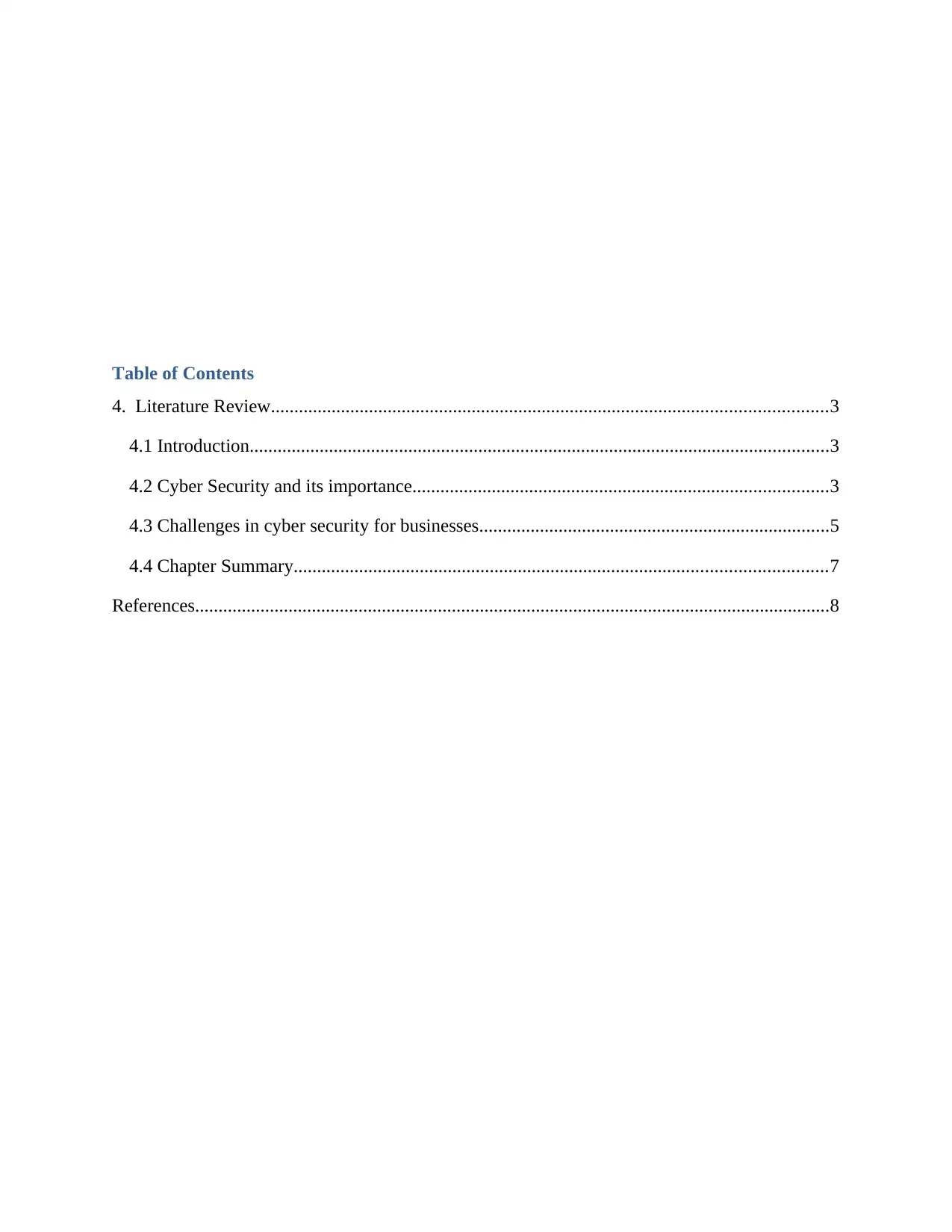
Table of Contents
4. Literature Review.......................................................................................................................3
4.1 Introduction............................................................................................................................3
4.2 Cyber Security and its importance.........................................................................................3
4.3 Challenges in cyber security for businesses...........................................................................5
4.4 Chapter Summary..................................................................................................................7
References........................................................................................................................................8
4. Literature Review.......................................................................................................................3
4.1 Introduction............................................................................................................................3
4.2 Cyber Security and its importance.........................................................................................3
4.3 Challenges in cyber security for businesses...........................................................................5
4.4 Chapter Summary..................................................................................................................7
References........................................................................................................................................8
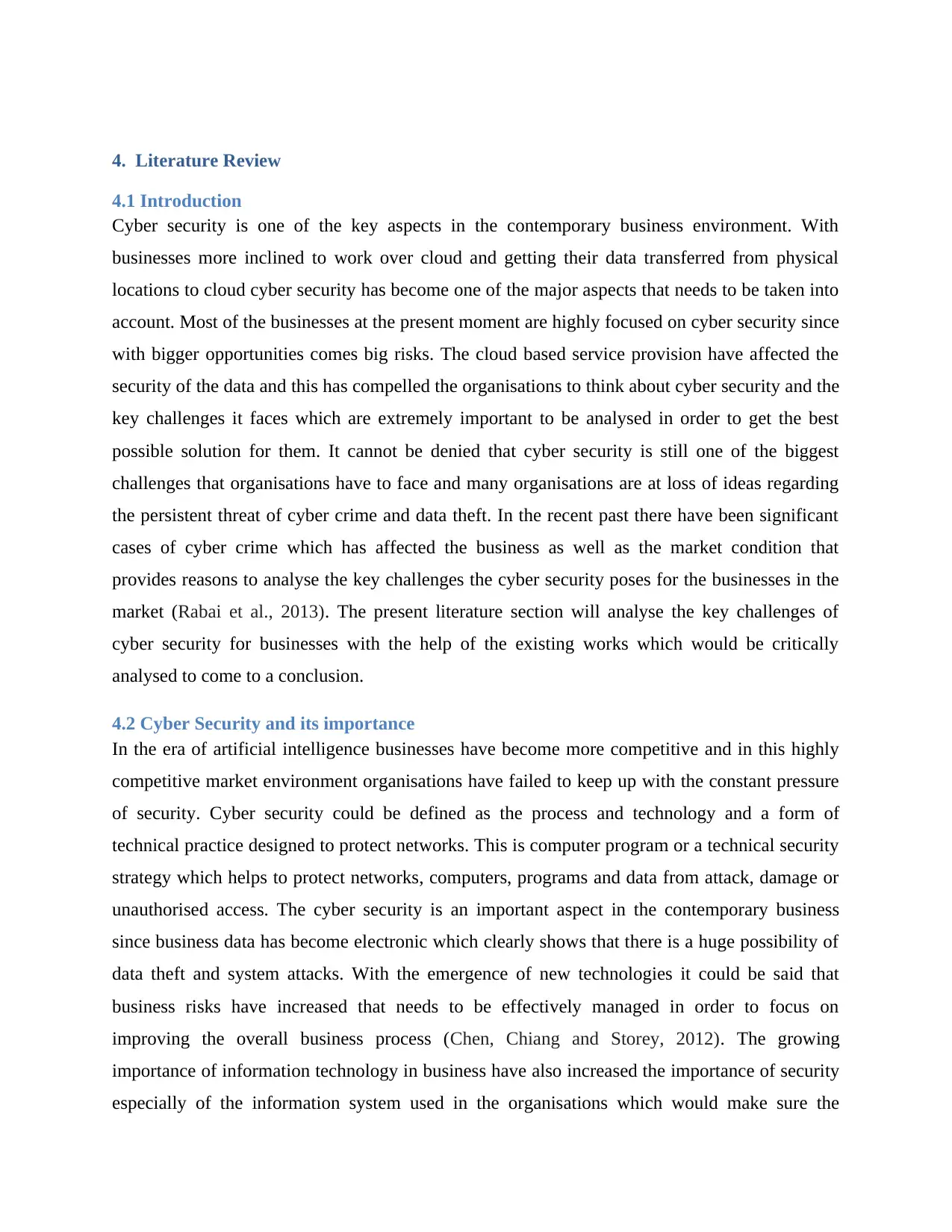
4. Literature Review
4.1 Introduction
Cyber security is one of the key aspects in the contemporary business environment. With
businesses more inclined to work over cloud and getting their data transferred from physical
locations to cloud cyber security has become one of the major aspects that needs to be taken into
account. Most of the businesses at the present moment are highly focused on cyber security since
with bigger opportunities comes big risks. The cloud based service provision have affected the
security of the data and this has compelled the organisations to think about cyber security and the
key challenges it faces which are extremely important to be analysed in order to get the best
possible solution for them. It cannot be denied that cyber security is still one of the biggest
challenges that organisations have to face and many organisations are at loss of ideas regarding
the persistent threat of cyber crime and data theft. In the recent past there have been significant
cases of cyber crime which has affected the business as well as the market condition that
provides reasons to analyse the key challenges the cyber security poses for the businesses in the
market (Rabai et al., 2013). The present literature section will analyse the key challenges of
cyber security for businesses with the help of the existing works which would be critically
analysed to come to a conclusion.
4.2 Cyber Security and its importance
In the era of artificial intelligence businesses have become more competitive and in this highly
competitive market environment organisations have failed to keep up with the constant pressure
of security. Cyber security could be defined as the process and technology and a form of
technical practice designed to protect networks. This is computer program or a technical security
strategy which helps to protect networks, computers, programs and data from attack, damage or
unauthorised access. The cyber security is an important aspect in the contemporary business
since business data has become electronic which clearly shows that there is a huge possibility of
data theft and system attacks. With the emergence of new technologies it could be said that
business risks have increased that needs to be effectively managed in order to focus on
improving the overall business process (Chen, Chiang and Storey, 2012). The growing
importance of information technology in business have also increased the importance of security
especially of the information system used in the organisations which would make sure the
4.1 Introduction
Cyber security is one of the key aspects in the contemporary business environment. With
businesses more inclined to work over cloud and getting their data transferred from physical
locations to cloud cyber security has become one of the major aspects that needs to be taken into
account. Most of the businesses at the present moment are highly focused on cyber security since
with bigger opportunities comes big risks. The cloud based service provision have affected the
security of the data and this has compelled the organisations to think about cyber security and the
key challenges it faces which are extremely important to be analysed in order to get the best
possible solution for them. It cannot be denied that cyber security is still one of the biggest
challenges that organisations have to face and many organisations are at loss of ideas regarding
the persistent threat of cyber crime and data theft. In the recent past there have been significant
cases of cyber crime which has affected the business as well as the market condition that
provides reasons to analyse the key challenges the cyber security poses for the businesses in the
market (Rabai et al., 2013). The present literature section will analyse the key challenges of
cyber security for businesses with the help of the existing works which would be critically
analysed to come to a conclusion.
4.2 Cyber Security and its importance
In the era of artificial intelligence businesses have become more competitive and in this highly
competitive market environment organisations have failed to keep up with the constant pressure
of security. Cyber security could be defined as the process and technology and a form of
technical practice designed to protect networks. This is computer program or a technical security
strategy which helps to protect networks, computers, programs and data from attack, damage or
unauthorised access. The cyber security is an important aspect in the contemporary business
since business data has become electronic which clearly shows that there is a huge possibility of
data theft and system attacks. With the emergence of new technologies it could be said that
business risks have increased that needs to be effectively managed in order to focus on
improving the overall business process (Chen, Chiang and Storey, 2012). The growing
importance of information technology in business have also increased the importance of security
especially of the information system used in the organisations which would make sure the
⊘ This is a preview!⊘
Do you want full access?
Subscribe today to unlock all pages.

Trusted by 1+ million students worldwide
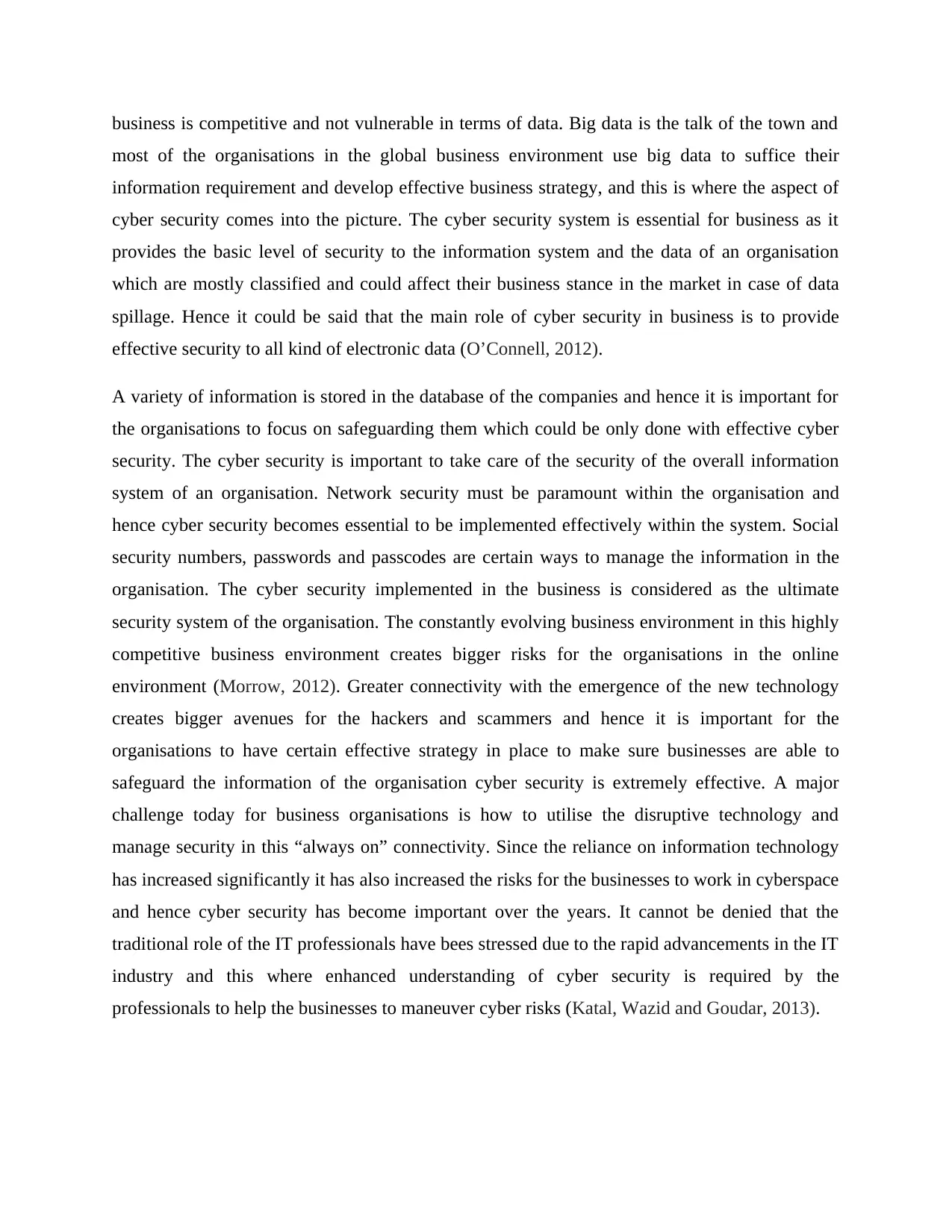
business is competitive and not vulnerable in terms of data. Big data is the talk of the town and
most of the organisations in the global business environment use big data to suffice their
information requirement and develop effective business strategy, and this is where the aspect of
cyber security comes into the picture. The cyber security system is essential for business as it
provides the basic level of security to the information system and the data of an organisation
which are mostly classified and could affect their business stance in the market in case of data
spillage. Hence it could be said that the main role of cyber security in business is to provide
effective security to all kind of electronic data (O’Connell, 2012).
A variety of information is stored in the database of the companies and hence it is important for
the organisations to focus on safeguarding them which could be only done with effective cyber
security. The cyber security is important to take care of the security of the overall information
system of an organisation. Network security must be paramount within the organisation and
hence cyber security becomes essential to be implemented effectively within the system. Social
security numbers, passwords and passcodes are certain ways to manage the information in the
organisation. The cyber security implemented in the business is considered as the ultimate
security system of the organisation. The constantly evolving business environment in this highly
competitive business environment creates bigger risks for the organisations in the online
environment (Morrow, 2012). Greater connectivity with the emergence of the new technology
creates bigger avenues for the hackers and scammers and hence it is important for the
organisations to have certain effective strategy in place to make sure businesses are able to
safeguard the information of the organisation cyber security is extremely effective. A major
challenge today for business organisations is how to utilise the disruptive technology and
manage security in this “always on” connectivity. Since the reliance on information technology
has increased significantly it has also increased the risks for the businesses to work in cyberspace
and hence cyber security has become important over the years. It cannot be denied that the
traditional role of the IT professionals have bees stressed due to the rapid advancements in the IT
industry and this where enhanced understanding of cyber security is required by the
professionals to help the businesses to maneuver cyber risks (Katal, Wazid and Goudar, 2013).
most of the organisations in the global business environment use big data to suffice their
information requirement and develop effective business strategy, and this is where the aspect of
cyber security comes into the picture. The cyber security system is essential for business as it
provides the basic level of security to the information system and the data of an organisation
which are mostly classified and could affect their business stance in the market in case of data
spillage. Hence it could be said that the main role of cyber security in business is to provide
effective security to all kind of electronic data (O’Connell, 2012).
A variety of information is stored in the database of the companies and hence it is important for
the organisations to focus on safeguarding them which could be only done with effective cyber
security. The cyber security is important to take care of the security of the overall information
system of an organisation. Network security must be paramount within the organisation and
hence cyber security becomes essential to be implemented effectively within the system. Social
security numbers, passwords and passcodes are certain ways to manage the information in the
organisation. The cyber security implemented in the business is considered as the ultimate
security system of the organisation. The constantly evolving business environment in this highly
competitive business environment creates bigger risks for the organisations in the online
environment (Morrow, 2012). Greater connectivity with the emergence of the new technology
creates bigger avenues for the hackers and scammers and hence it is important for the
organisations to have certain effective strategy in place to make sure businesses are able to
safeguard the information of the organisation cyber security is extremely effective. A major
challenge today for business organisations is how to utilise the disruptive technology and
manage security in this “always on” connectivity. Since the reliance on information technology
has increased significantly it has also increased the risks for the businesses to work in cyberspace
and hence cyber security has become important over the years. It cannot be denied that the
traditional role of the IT professionals have bees stressed due to the rapid advancements in the IT
industry and this where enhanced understanding of cyber security is required by the
professionals to help the businesses to maneuver cyber risks (Katal, Wazid and Goudar, 2013).
Paraphrase This Document
Need a fresh take? Get an instant paraphrase of this document with our AI Paraphraser
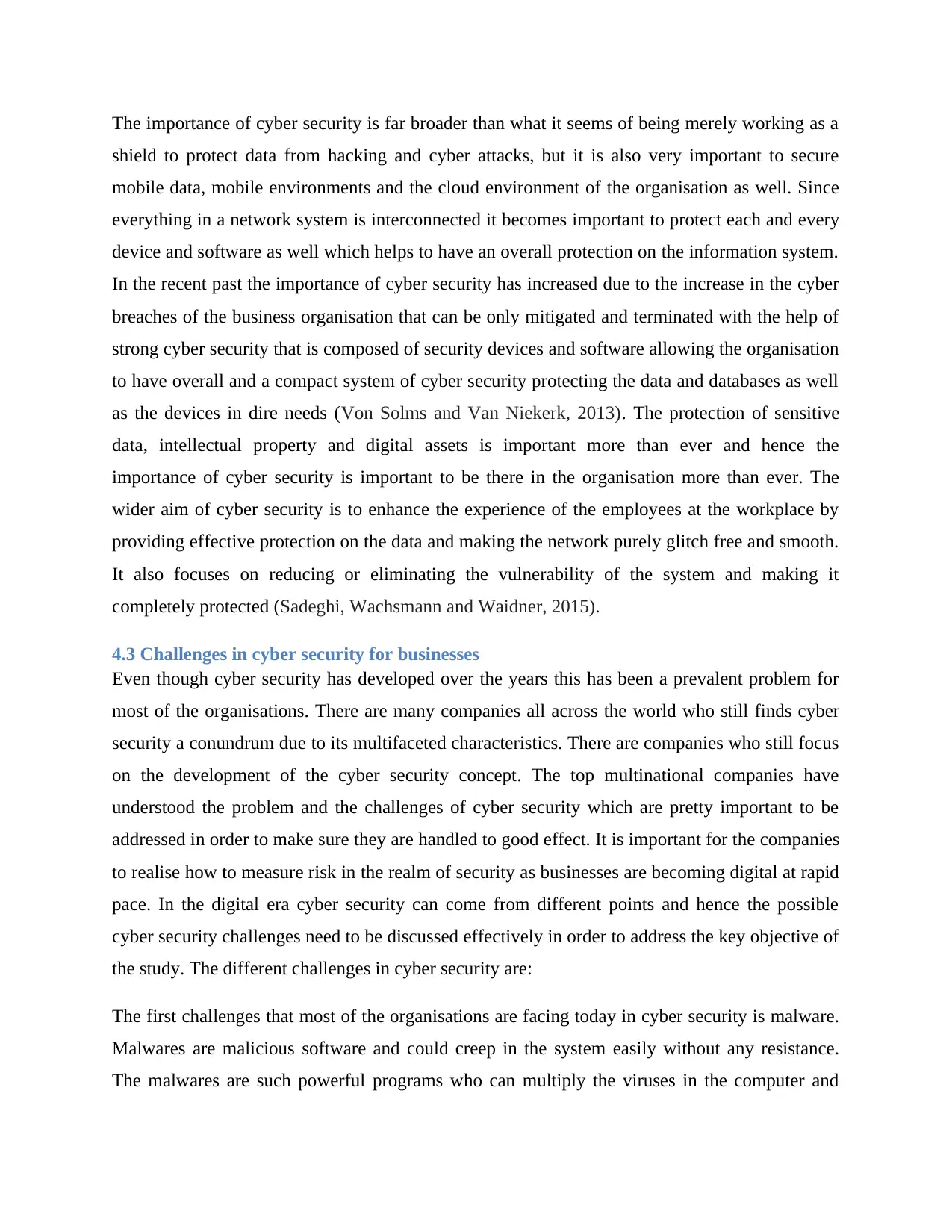
The importance of cyber security is far broader than what it seems of being merely working as a
shield to protect data from hacking and cyber attacks, but it is also very important to secure
mobile data, mobile environments and the cloud environment of the organisation as well. Since
everything in a network system is interconnected it becomes important to protect each and every
device and software as well which helps to have an overall protection on the information system.
In the recent past the importance of cyber security has increased due to the increase in the cyber
breaches of the business organisation that can be only mitigated and terminated with the help of
strong cyber security that is composed of security devices and software allowing the organisation
to have overall and a compact system of cyber security protecting the data and databases as well
as the devices in dire needs (Von Solms and Van Niekerk, 2013). The protection of sensitive
data, intellectual property and digital assets is important more than ever and hence the
importance of cyber security is important to be there in the organisation more than ever. The
wider aim of cyber security is to enhance the experience of the employees at the workplace by
providing effective protection on the data and making the network purely glitch free and smooth.
It also focuses on reducing or eliminating the vulnerability of the system and making it
completely protected (Sadeghi, Wachsmann and Waidner, 2015).
4.3 Challenges in cyber security for businesses
Even though cyber security has developed over the years this has been a prevalent problem for
most of the organisations. There are many companies all across the world who still finds cyber
security a conundrum due to its multifaceted characteristics. There are companies who still focus
on the development of the cyber security concept. The top multinational companies have
understood the problem and the challenges of cyber security which are pretty important to be
addressed in order to make sure they are handled to good effect. It is important for the companies
to realise how to measure risk in the realm of security as businesses are becoming digital at rapid
pace. In the digital era cyber security can come from different points and hence the possible
cyber security challenges need to be discussed effectively in order to address the key objective of
the study. The different challenges in cyber security are:
The first challenges that most of the organisations are facing today in cyber security is malware.
Malwares are malicious software and could creep in the system easily without any resistance.
The malwares are such powerful programs who can multiply the viruses in the computer and
shield to protect data from hacking and cyber attacks, but it is also very important to secure
mobile data, mobile environments and the cloud environment of the organisation as well. Since
everything in a network system is interconnected it becomes important to protect each and every
device and software as well which helps to have an overall protection on the information system.
In the recent past the importance of cyber security has increased due to the increase in the cyber
breaches of the business organisation that can be only mitigated and terminated with the help of
strong cyber security that is composed of security devices and software allowing the organisation
to have overall and a compact system of cyber security protecting the data and databases as well
as the devices in dire needs (Von Solms and Van Niekerk, 2013). The protection of sensitive
data, intellectual property and digital assets is important more than ever and hence the
importance of cyber security is important to be there in the organisation more than ever. The
wider aim of cyber security is to enhance the experience of the employees at the workplace by
providing effective protection on the data and making the network purely glitch free and smooth.
It also focuses on reducing or eliminating the vulnerability of the system and making it
completely protected (Sadeghi, Wachsmann and Waidner, 2015).
4.3 Challenges in cyber security for businesses
Even though cyber security has developed over the years this has been a prevalent problem for
most of the organisations. There are many companies all across the world who still finds cyber
security a conundrum due to its multifaceted characteristics. There are companies who still focus
on the development of the cyber security concept. The top multinational companies have
understood the problem and the challenges of cyber security which are pretty important to be
addressed in order to make sure they are handled to good effect. It is important for the companies
to realise how to measure risk in the realm of security as businesses are becoming digital at rapid
pace. In the digital era cyber security can come from different points and hence the possible
cyber security challenges need to be discussed effectively in order to address the key objective of
the study. The different challenges in cyber security are:
The first challenges that most of the organisations are facing today in cyber security is malware.
Malwares are malicious software and could creep in the system easily without any resistance.
The malwares are such powerful programs who can multiply the viruses in the computer and
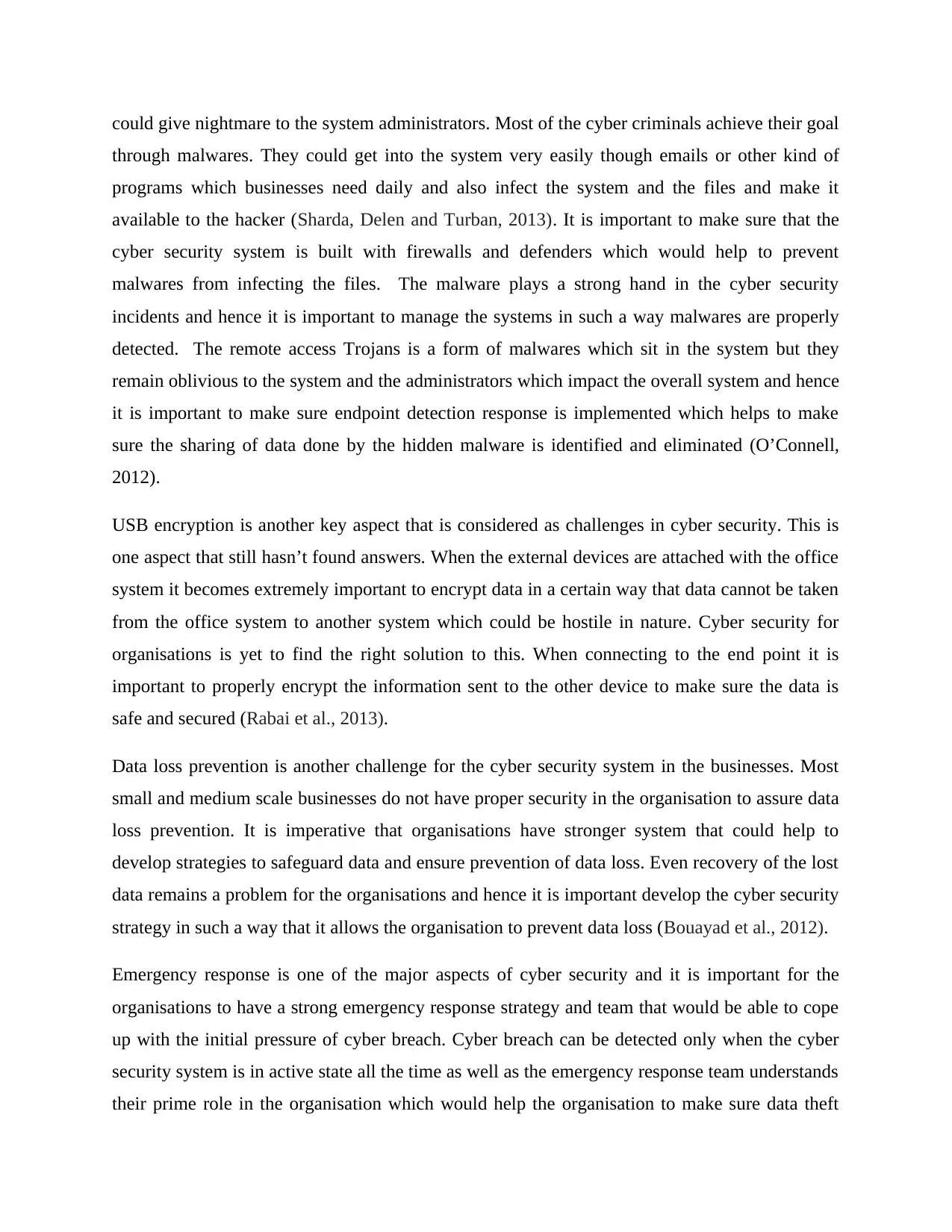
could give nightmare to the system administrators. Most of the cyber criminals achieve their goal
through malwares. They could get into the system very easily though emails or other kind of
programs which businesses need daily and also infect the system and the files and make it
available to the hacker (Sharda, Delen and Turban, 2013). It is important to make sure that the
cyber security system is built with firewalls and defenders which would help to prevent
malwares from infecting the files. The malware plays a strong hand in the cyber security
incidents and hence it is important to manage the systems in such a way malwares are properly
detected. The remote access Trojans is a form of malwares which sit in the system but they
remain oblivious to the system and the administrators which impact the overall system and hence
it is important to make sure endpoint detection response is implemented which helps to make
sure the sharing of data done by the hidden malware is identified and eliminated (O’Connell,
2012).
USB encryption is another key aspect that is considered as challenges in cyber security. This is
one aspect that still hasn’t found answers. When the external devices are attached with the office
system it becomes extremely important to encrypt data in a certain way that data cannot be taken
from the office system to another system which could be hostile in nature. Cyber security for
organisations is yet to find the right solution to this. When connecting to the end point it is
important to properly encrypt the information sent to the other device to make sure the data is
safe and secured (Rabai et al., 2013).
Data loss prevention is another challenge for the cyber security system in the businesses. Most
small and medium scale businesses do not have proper security in the organisation to assure data
loss prevention. It is imperative that organisations have stronger system that could help to
develop strategies to safeguard data and ensure prevention of data loss. Even recovery of the lost
data remains a problem for the organisations and hence it is important develop the cyber security
strategy in such a way that it allows the organisation to prevent data loss (Bouayad et al., 2012).
Emergency response is one of the major aspects of cyber security and it is important for the
organisations to have a strong emergency response strategy and team that would be able to cope
up with the initial pressure of cyber breach. Cyber breach can be detected only when the cyber
security system is in active state all the time as well as the emergency response team understands
their prime role in the organisation which would help the organisation to make sure data theft
through malwares. They could get into the system very easily though emails or other kind of
programs which businesses need daily and also infect the system and the files and make it
available to the hacker (Sharda, Delen and Turban, 2013). It is important to make sure that the
cyber security system is built with firewalls and defenders which would help to prevent
malwares from infecting the files. The malware plays a strong hand in the cyber security
incidents and hence it is important to manage the systems in such a way malwares are properly
detected. The remote access Trojans is a form of malwares which sit in the system but they
remain oblivious to the system and the administrators which impact the overall system and hence
it is important to make sure endpoint detection response is implemented which helps to make
sure the sharing of data done by the hidden malware is identified and eliminated (O’Connell,
2012).
USB encryption is another key aspect that is considered as challenges in cyber security. This is
one aspect that still hasn’t found answers. When the external devices are attached with the office
system it becomes extremely important to encrypt data in a certain way that data cannot be taken
from the office system to another system which could be hostile in nature. Cyber security for
organisations is yet to find the right solution to this. When connecting to the end point it is
important to properly encrypt the information sent to the other device to make sure the data is
safe and secured (Rabai et al., 2013).
Data loss prevention is another challenge for the cyber security system in the businesses. Most
small and medium scale businesses do not have proper security in the organisation to assure data
loss prevention. It is imperative that organisations have stronger system that could help to
develop strategies to safeguard data and ensure prevention of data loss. Even recovery of the lost
data remains a problem for the organisations and hence it is important develop the cyber security
strategy in such a way that it allows the organisation to prevent data loss (Bouayad et al., 2012).
Emergency response is one of the major aspects of cyber security and it is important for the
organisations to have a strong emergency response strategy and team that would be able to cope
up with the initial pressure of cyber breach. Cyber breach can be detected only when the cyber
security system is in active state all the time as well as the emergency response team understands
their prime role in the organisation which would help the organisation to make sure data theft
⊘ This is a preview!⊘
Do you want full access?
Subscribe today to unlock all pages.

Trusted by 1+ million students worldwide
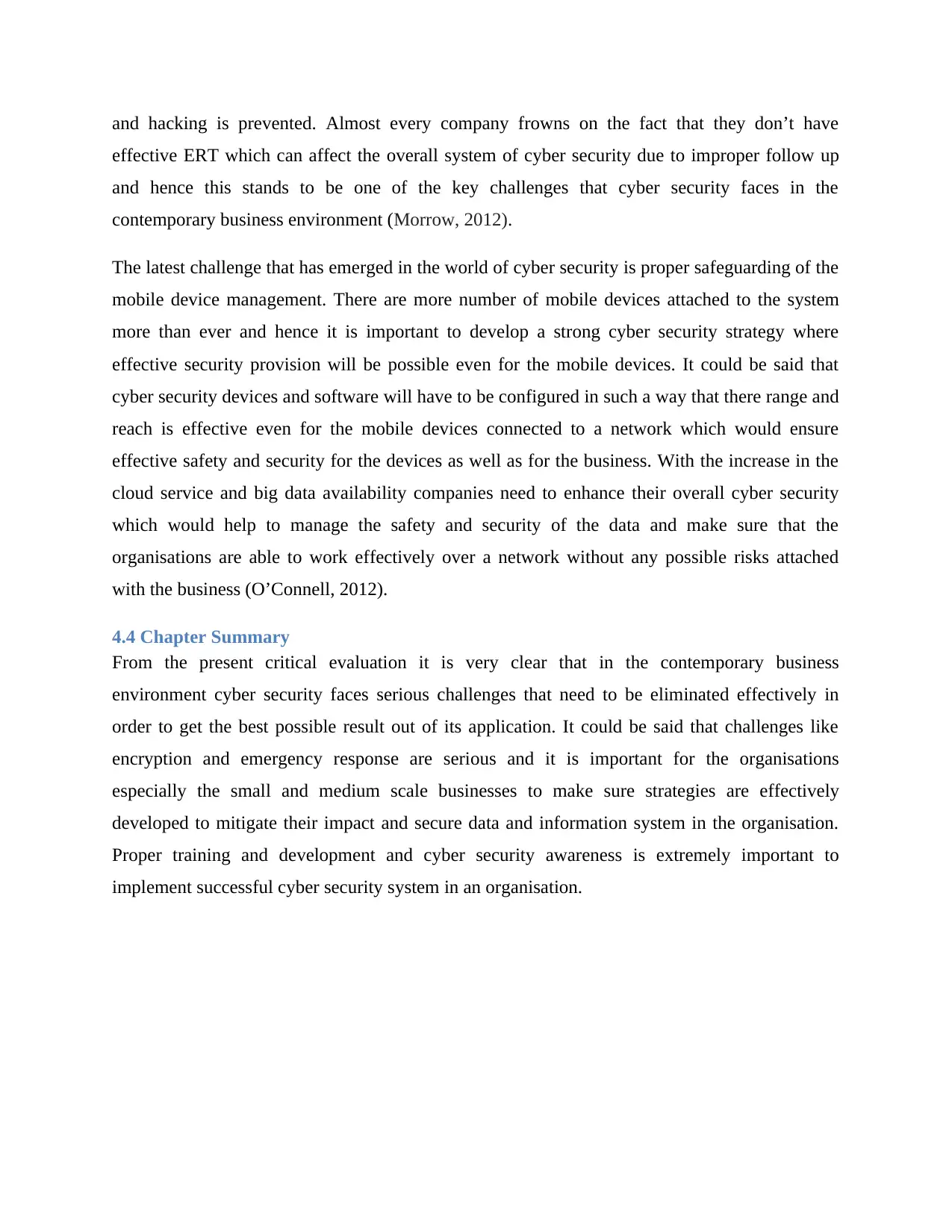
and hacking is prevented. Almost every company frowns on the fact that they don’t have
effective ERT which can affect the overall system of cyber security due to improper follow up
and hence this stands to be one of the key challenges that cyber security faces in the
contemporary business environment (Morrow, 2012).
The latest challenge that has emerged in the world of cyber security is proper safeguarding of the
mobile device management. There are more number of mobile devices attached to the system
more than ever and hence it is important to develop a strong cyber security strategy where
effective security provision will be possible even for the mobile devices. It could be said that
cyber security devices and software will have to be configured in such a way that there range and
reach is effective even for the mobile devices connected to a network which would ensure
effective safety and security for the devices as well as for the business. With the increase in the
cloud service and big data availability companies need to enhance their overall cyber security
which would help to manage the safety and security of the data and make sure that the
organisations are able to work effectively over a network without any possible risks attached
with the business (O’Connell, 2012).
4.4 Chapter Summary
From the present critical evaluation it is very clear that in the contemporary business
environment cyber security faces serious challenges that need to be eliminated effectively in
order to get the best possible result out of its application. It could be said that challenges like
encryption and emergency response are serious and it is important for the organisations
especially the small and medium scale businesses to make sure strategies are effectively
developed to mitigate their impact and secure data and information system in the organisation.
Proper training and development and cyber security awareness is extremely important to
implement successful cyber security system in an organisation.
effective ERT which can affect the overall system of cyber security due to improper follow up
and hence this stands to be one of the key challenges that cyber security faces in the
contemporary business environment (Morrow, 2012).
The latest challenge that has emerged in the world of cyber security is proper safeguarding of the
mobile device management. There are more number of mobile devices attached to the system
more than ever and hence it is important to develop a strong cyber security strategy where
effective security provision will be possible even for the mobile devices. It could be said that
cyber security devices and software will have to be configured in such a way that there range and
reach is effective even for the mobile devices connected to a network which would ensure
effective safety and security for the devices as well as for the business. With the increase in the
cloud service and big data availability companies need to enhance their overall cyber security
which would help to manage the safety and security of the data and make sure that the
organisations are able to work effectively over a network without any possible risks attached
with the business (O’Connell, 2012).
4.4 Chapter Summary
From the present critical evaluation it is very clear that in the contemporary business
environment cyber security faces serious challenges that need to be eliminated effectively in
order to get the best possible result out of its application. It could be said that challenges like
encryption and emergency response are serious and it is important for the organisations
especially the small and medium scale businesses to make sure strategies are effectively
developed to mitigate their impact and secure data and information system in the organisation.
Proper training and development and cyber security awareness is extremely important to
implement successful cyber security system in an organisation.
Paraphrase This Document
Need a fresh take? Get an instant paraphrase of this document with our AI Paraphraser
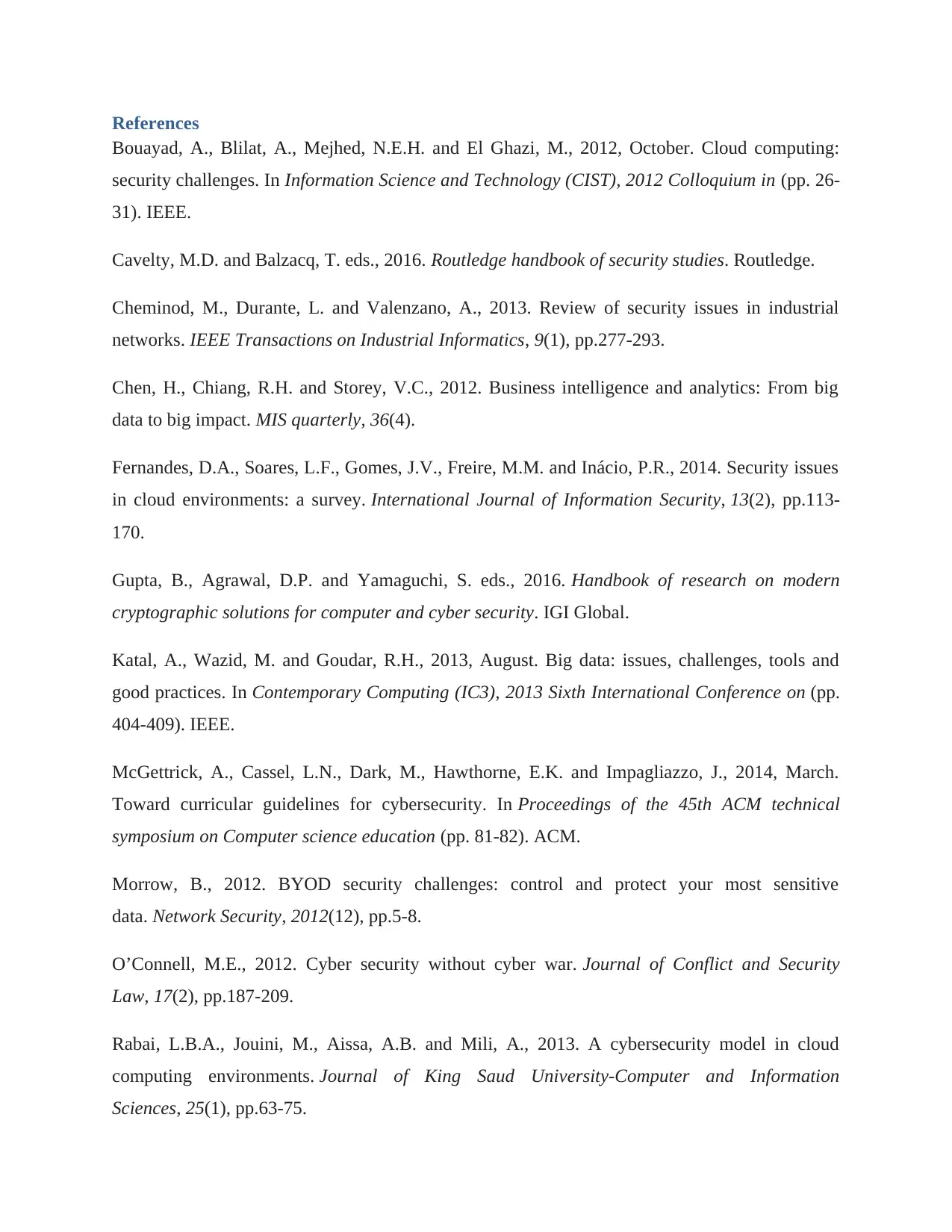
References
Bouayad, A., Blilat, A., Mejhed, N.E.H. and El Ghazi, M., 2012, October. Cloud computing:
security challenges. In Information Science and Technology (CIST), 2012 Colloquium in (pp. 26-
31). IEEE.
Cavelty, M.D. and Balzacq, T. eds., 2016. Routledge handbook of security studies. Routledge.
Cheminod, M., Durante, L. and Valenzano, A., 2013. Review of security issues in industrial
networks. IEEE Transactions on Industrial Informatics, 9(1), pp.277-293.
Chen, H., Chiang, R.H. and Storey, V.C., 2012. Business intelligence and analytics: From big
data to big impact. MIS quarterly, 36(4).
Fernandes, D.A., Soares, L.F., Gomes, J.V., Freire, M.M. and Inácio, P.R., 2014. Security issues
in cloud environments: a survey. International Journal of Information Security, 13(2), pp.113-
170.
Gupta, B., Agrawal, D.P. and Yamaguchi, S. eds., 2016. Handbook of research on modern
cryptographic solutions for computer and cyber security. IGI Global.
Katal, A., Wazid, M. and Goudar, R.H., 2013, August. Big data: issues, challenges, tools and
good practices. In Contemporary Computing (IC3), 2013 Sixth International Conference on (pp.
404-409). IEEE.
McGettrick, A., Cassel, L.N., Dark, M., Hawthorne, E.K. and Impagliazzo, J., 2014, March.
Toward curricular guidelines for cybersecurity. In Proceedings of the 45th ACM technical
symposium on Computer science education (pp. 81-82). ACM.
Morrow, B., 2012. BYOD security challenges: control and protect your most sensitive
data. Network Security, 2012(12), pp.5-8.
O’Connell, M.E., 2012. Cyber security without cyber war. Journal of Conflict and Security
Law, 17(2), pp.187-209.
Rabai, L.B.A., Jouini, M., Aissa, A.B. and Mili, A., 2013. A cybersecurity model in cloud
computing environments. Journal of King Saud University-Computer and Information
Sciences, 25(1), pp.63-75.
Bouayad, A., Blilat, A., Mejhed, N.E.H. and El Ghazi, M., 2012, October. Cloud computing:
security challenges. In Information Science and Technology (CIST), 2012 Colloquium in (pp. 26-
31). IEEE.
Cavelty, M.D. and Balzacq, T. eds., 2016. Routledge handbook of security studies. Routledge.
Cheminod, M., Durante, L. and Valenzano, A., 2013. Review of security issues in industrial
networks. IEEE Transactions on Industrial Informatics, 9(1), pp.277-293.
Chen, H., Chiang, R.H. and Storey, V.C., 2012. Business intelligence and analytics: From big
data to big impact. MIS quarterly, 36(4).
Fernandes, D.A., Soares, L.F., Gomes, J.V., Freire, M.M. and Inácio, P.R., 2014. Security issues
in cloud environments: a survey. International Journal of Information Security, 13(2), pp.113-
170.
Gupta, B., Agrawal, D.P. and Yamaguchi, S. eds., 2016. Handbook of research on modern
cryptographic solutions for computer and cyber security. IGI Global.
Katal, A., Wazid, M. and Goudar, R.H., 2013, August. Big data: issues, challenges, tools and
good practices. In Contemporary Computing (IC3), 2013 Sixth International Conference on (pp.
404-409). IEEE.
McGettrick, A., Cassel, L.N., Dark, M., Hawthorne, E.K. and Impagliazzo, J., 2014, March.
Toward curricular guidelines for cybersecurity. In Proceedings of the 45th ACM technical
symposium on Computer science education (pp. 81-82). ACM.
Morrow, B., 2012. BYOD security challenges: control and protect your most sensitive
data. Network Security, 2012(12), pp.5-8.
O’Connell, M.E., 2012. Cyber security without cyber war. Journal of Conflict and Security
Law, 17(2), pp.187-209.
Rabai, L.B.A., Jouini, M., Aissa, A.B. and Mili, A., 2013. A cybersecurity model in cloud
computing environments. Journal of King Saud University-Computer and Information
Sciences, 25(1), pp.63-75.
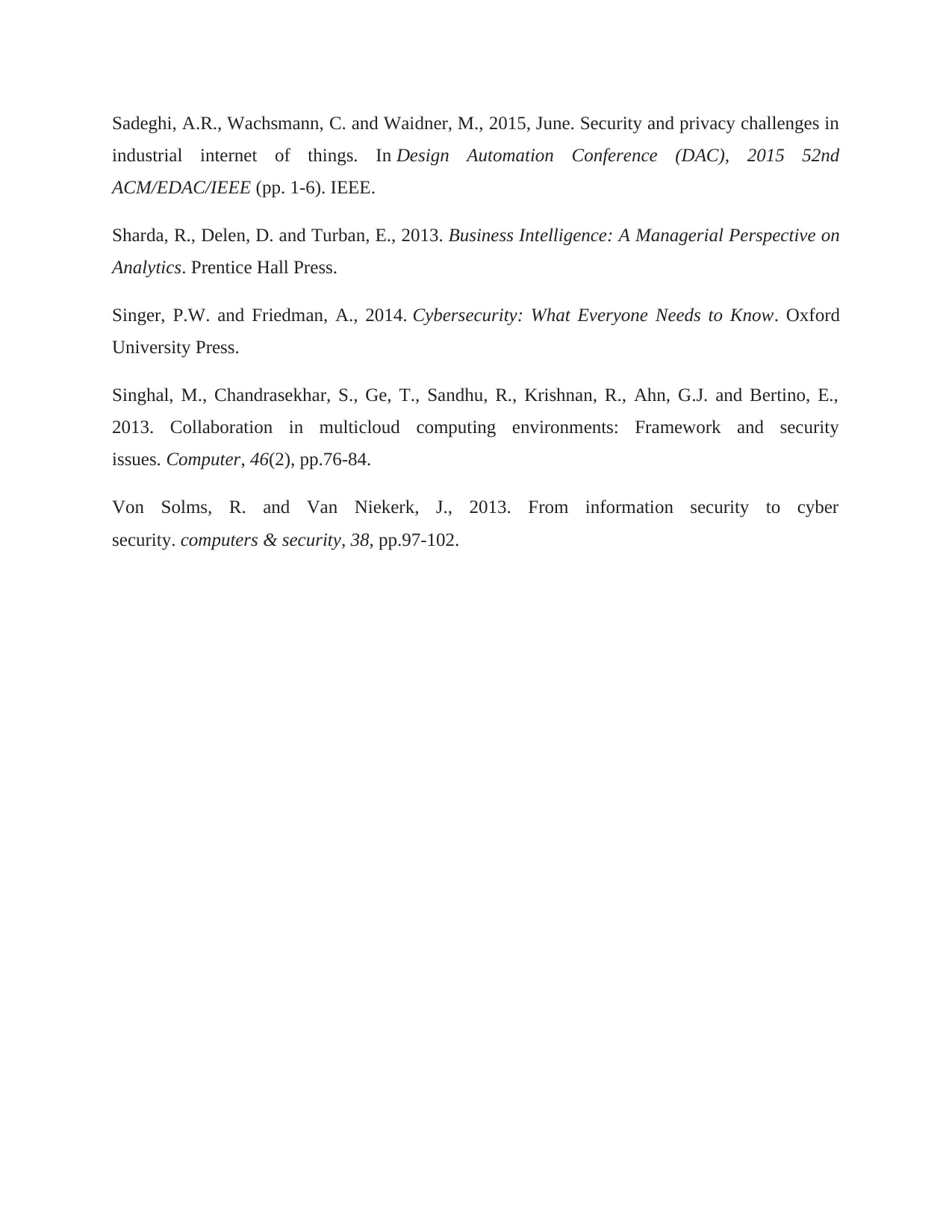
Sadeghi, A.R., Wachsmann, C. and Waidner, M., 2015, June. Security and privacy challenges in
industrial internet of things. In Design Automation Conference (DAC), 2015 52nd
ACM/EDAC/IEEE (pp. 1-6). IEEE.
Sharda, R., Delen, D. and Turban, E., 2013. Business Intelligence: A Managerial Perspective on
Analytics. Prentice Hall Press.
Singer, P.W. and Friedman, A., 2014. Cybersecurity: What Everyone Needs to Know. Oxford
University Press.
Singhal, M., Chandrasekhar, S., Ge, T., Sandhu, R., Krishnan, R., Ahn, G.J. and Bertino, E.,
2013. Collaboration in multicloud computing environments: Framework and security
issues. Computer, 46(2), pp.76-84.
Von Solms, R. and Van Niekerk, J., 2013. From information security to cyber
security. computers & security, 38, pp.97-102.
industrial internet of things. In Design Automation Conference (DAC), 2015 52nd
ACM/EDAC/IEEE (pp. 1-6). IEEE.
Sharda, R., Delen, D. and Turban, E., 2013. Business Intelligence: A Managerial Perspective on
Analytics. Prentice Hall Press.
Singer, P.W. and Friedman, A., 2014. Cybersecurity: What Everyone Needs to Know. Oxford
University Press.
Singhal, M., Chandrasekhar, S., Ge, T., Sandhu, R., Krishnan, R., Ahn, G.J. and Bertino, E.,
2013. Collaboration in multicloud computing environments: Framework and security
issues. Computer, 46(2), pp.76-84.
Von Solms, R. and Van Niekerk, J., 2013. From information security to cyber
security. computers & security, 38, pp.97-102.
⊘ This is a preview!⊘
Do you want full access?
Subscribe today to unlock all pages.

Trusted by 1+ million students worldwide
1 out of 9
Related Documents
Your All-in-One AI-Powered Toolkit for Academic Success.
+13062052269
info@desklib.com
Available 24*7 on WhatsApp / Email
![[object Object]](/_next/static/media/star-bottom.7253800d.svg)
Unlock your academic potential
Copyright © 2020–2025 A2Z Services. All Rights Reserved. Developed and managed by ZUCOL.





